Analytical Study on Reinforced Concrete Columns and Composite Columns under Lateral Impact
Abstract
1. Introduction
2. Finite Element Model
2.1. Composite Column Parameters
2.2. Finite Element Mesh and Contact Definition
2.3. Materials Properties
3. Validation of the FEA Model
4. Impact Mechanism Analysis
4.1. The Impact Process
- (1)
- Peak stage (OA): When the drop hammer touches the specimen, the impact force increases rapidly from zero to the peak value. The specimen demonstrates a downward velocity which rapidly increases to the peak value, which is equivalent to the impact velocity. At the same time, the velocity of the drop hammer decreases. During this stage, a small lateral displacement occurs in the specimen;
- (2)
- Plateau stage (AB): After the impact force reaches ita peak, the specimen velocity decreases to a certain extent, and the velocity of the drop hammer fluctuates slightly. It is the difference in the two velocities that causes the sharp decrease in the impact force. Then, the drop hammer increases the specimen velocity again, and the corresponding impact force also increases after several fluctuations. After several fluctuations, the value remains stable. Subsequently, the drop hammer velocity stays consistent with the mid-span velocity of the specimen, and gradually decreases to zero;
- (3)
- Attenuation stage (BC): At this stage, the drop hammer and the specimen begin to rebound, and the rebound velocity of the drop hammer is greater than that of the specimen, resulting in a decline in the impact force. When the specimen is separated from the drop hammer, the impact force drops to zero. After the specimen reaches the maximum mid-span displacement, the mid-span displacement of the specimen begins to decrease due to the rebound. With the recovery of elastic displacement, the mid-span displacement of the specimen remains stable and recovers to the residual deflection.
4.2. Deformation Mode
4.3. Energy Dissipation
5. Parametric Sensitivity Analysis
6. Conclusions
- (1)
- The impact resistance of composite columns is better than that of RC columns. The axial force weakens the impact resistance of the composite column regardless of its cross-sectional form;
- (2)
- In all composite columns, the impact process is similar, and the impact force–time curve shows three stages: peak stage, plateau stage and attenuation stage. Among them, S-DS columns have the best impact resistance, showing a higher impact platform value and a smaller peak deflection under an impact with the same energy;
- (3)
- The simulation results of LS-DYNA fit well with the experimental results. The software is used to analyze the impact process of composite columns, and it is found that the outer steel tube is the main energy dissipation component of these components, which can absorb 50%–60% of impact energy, followed by concrete (about 24% of impact energy), the inner steel tube and the double H-shaped steel (about 12% of impact energy);
- (4)
- LS-DYNA nonlinear finite element software was used to analyze the sensitivity of composite columns. Although the cross-sectional forms of different composite columns were different, the sensitivities of peak impact force, impact duration and peak deflection to parameter changes were similar. The impact velocity and diameter–thickness ratio of the outer steel tube have a great influence on the energy dissipation of the structural column, while the influence of the inner steel tube and the double H-shaped steel is the least, and the influence of concrete is in the middle;
- (5)
- To increase the impact resistance, the best solution is to increase the thickness of the outer steel tube, followed by the yield strength of the outer steel tube and the compressive strength of concrete, and the least economic solution is to improve the impact resistance of components through the mechanical parameters of the inner steel tube.
Author Contributions
Funding
Institutional Review Board Statement
Informed Consent Statement
Data Availability Statement
Acknowledgments
Conflicts of Interest
References
- Xu, L.; Lu, X.-Z.; Smith, S.; He, S.-T. Scaled model test for collision between over-height truck and bridge superstructure. Int. J. Impact Eng. 2012, 49, 31–42. [Google Scholar] [CrossRef]
- Xu, L.; Lu, X.-Z.; Guan, H.; Zhang, Y.-Z. Finite-element and simplified models for collision simulation between over-height trucks and bridge superstructures. J. Bridge Eng. 2013, 18, 1140–1151. [Google Scholar] [CrossRef]
- Zhu, X.; Lu, X.; Cheng, Q.; Li, Y. Simulation of the running attitude of a train after derailment. Int. J. Crashworthiness 2020, 25, 213–219. [Google Scholar] [CrossRef]
- Lu, X.; Lin, K.; Cen, S.; Xu, Z.; Lin, L. Comparing different fidelity models for the impact analysis of large commercial aircrafts on a containment building. Eng. Fail. Anal. 2015, 57, 254–269. [Google Scholar] [CrossRef]
- Sha, Y.; Amdahl, J.; Dørum, C. Dynamic responses of a floating bridge subjected to ship collision load on bridge girders. Procedia Eng. 2017, 199, 2506–2513. [Google Scholar] [CrossRef]
- Zhao, X.-L.; Tong, L.-W.; Wang, X.-Y. CFDST stub columns subjected to large deformation axial loading. Eng. Struct. 2010, 32, 692–703. [Google Scholar] [CrossRef]
- Zhu, M.; Liu, J.; Wang, Q.; Feng, X. Experimental research on square steel tubular columns filled with steel-reinforced self-consolidating high-strength concrete under axial load. Eng. Struct. 2010, 32, 2278–2286. [Google Scholar] [CrossRef]
- Xian, W.; Wang, W.; Wang, R.; Chen, W.; Hao, H. Dynamic response of steel-reinforced concrete-filled circular steel tubular members under lateral impact losds. Thin-Walled Struct. 2020, 151, 106736. [Google Scholar] [CrossRef]
- Aghdamy, S.; Thambiratnam, D.P.; Dhanasekar, M. Experimental Investigation on Lateral Impact Response of Concrete-Filled Double-Skin Tube Columns Using Horizontal-Impact-Testing System. Exp. Mech. 2016, 56, 1133–1153. [Google Scholar] [CrossRef]
- Aghdamy, S.; Thambiratnam, D.; Dhanasekar, M.; Saiedi, S. Effects of load-related parameters on the response of concrete-filled double-skin steel tube columns subjected to lateral impact. J. Constr. Steel Res. 2017, 138, 642–662. [Google Scholar] [CrossRef]
- Zhu, X.; Zhang, Q.; Zhang, D.; Du, Y.; Zhang, Q. Experimental and numerical study on the dynamic response of steel- reinforced concrete composite members under lateral impact. Thin-Walled Struct. 2021, 169, 108477. [Google Scholar] [CrossRef]
- Zhu, X.; Kang, M.; Fei, Y.; Zhang, Q.; Wang, R. Impact behavior of concrete-filled steel tube with cruciform reinforcing steel under lateral impact load. Eng. Struct. 2021, 247, 113104. [Google Scholar] [CrossRef]
- Wang, R.; Han, L.-H.; Hou, C.-C. Behavior of concrete filled steel tubular (CFST) members under lateral impact: Experiment and FEA model. J. Constr. Steel Res. 2013, 80, 188–201. [Google Scholar] [CrossRef]
- Xu, J.; Demartino, C.; Shan, B.; Heo, Y.; Xiao, Y. Experimental investigation on performance of cantilever CFRP-wrapped circular RC columns under lateral low-velocity impact. Compos. Struct. 2020, 242, 112143. [Google Scholar] [CrossRef]
- Wang, B.; Zhu, H.; Wu, X.; Zhang, N.; Yan, B. Numerical investigation on low-velocity impact response of CFRP wraps in presence of concrete substrate. Compos. Struct. 2019, 231, 111541. [Google Scholar] [CrossRef]
- Han, L.-H.; Hou, C.-C.; Zhao, X.-L.; Rasmussen, K.J. Behaviour of high-strength concrete filled steel tubes under transverse impact loading. J. Constr. Steel Res. 2014, 92, 25–39. [Google Scholar] [CrossRef]
- Hu, C.-M.; Han, L.-H.; Hou, C.-C. Concrete-encased CFST members with circular sections under laterally low velocity impact: Analytical behaviour. J. Constr. Steel Res. 2018, 146, 135–154. [Google Scholar] [CrossRef]
- Hu, C.; Han, L. Experimental behaviour of circular concrete-encased concrete-filled steel tubes under lateral impact. China Civ. Eng. J. 2016, 49, 11–17. (In Chinese) [Google Scholar]
- Wang, R.; Han, L.-H.; Zhao, X.-L.; Rasmussen, K.J. Experimental behavior of concrete filled double steel tubular (CFDST) members under low velocity drop weight impact. Thin-Walled Struct. 2015, 97, 279–295. [Google Scholar] [CrossRef]
- Wang, R.; Han, L.-H.; Zhao, X.-L.; Rasmussen, K.J. Analytical behavior of concrete filled double steel tubular (CFDST) members under lateral impact. Thin-Walled Struct. 2016, 101, 129–140. [Google Scholar] [CrossRef]
- Goldston, M.; Remennikov, A.; Saleh, Z.; Sheikh, M.N. Experimental investigations on the behavior of GFRP bar reinforced HSC and UHSC beams under static and impact loading. Structures 2019, 22, 109–123. [Google Scholar] [CrossRef]
- Swesi, A.O.; Cotsovos, D.M.; Val, D.V. Effect of CFRP strengthening on response of RC columns to lateral static and impact loads. Compos. Struct. 2022, 287, 115356. [Google Scholar] [CrossRef]
- Zhu, X.; Zhao, P.; Tian, Y.; Wang, R. Experimental study of RC columns and composite columns under low-velocity impact. Thin-Walled Struct. 2020, 160, 107374. [Google Scholar] [CrossRef]
- GB50010-2010; Code for Design of Concrete Structures. China Architecture and Building Press: Beijing, China, 2015. (In Chinese)
- GB50936-2014; Technical Code for Concrete Filled Steel Tubular Structures. China Architecture and Building Press: Beijing, China, 2014. (In Chinese)
- Tao, Z.; Han, L.-H. Behaviour of concrete-filled double skin rectangular steel tubular beam–columns. J. Constr. Steel Res. 2005, 62, 631–646. [Google Scholar] [CrossRef]
- Zhang, C.; Yin, Y.; Zhou, Y. Experiment study on the axial load-bearing capacity of high-strength concrete-filled double tube elements. J. Guangzhou Univ. 2004, 3, 61–65. (In Chinese) [Google Scholar]
- Hu, R.-X.; Kang, S.-T. Case Guidance for ANSYS 18.0/LS-DYNA Nonlinear Finite Element Analysis; Machinery Industry Press: Beijing, China, 2018. (In Chinese) [Google Scholar]
- Li, M.; Zong, Z.; Hao, H.; Zhang, X.; Lin, J.; Liao, Y. Post-blast performance and residual capacity of CFDST columns subjected to contact explosions. J. Constr. Steel Res. 2020, 167, 105960. [Google Scholar] [CrossRef]
- ACI 318-2011; Building Code Requirements for Structural Concrete. American Concrete Institute: Farmington Hills, MI, USA, 2011.
- Tanimura, S.; Tsuda, T.; Abe, A.; Hayashi, H.; Jones, N. Comparison of rate-dependent constitutive models with experimental data. Int. J. Impact Eng. 2014, 69, 104–113. [Google Scholar] [CrossRef]
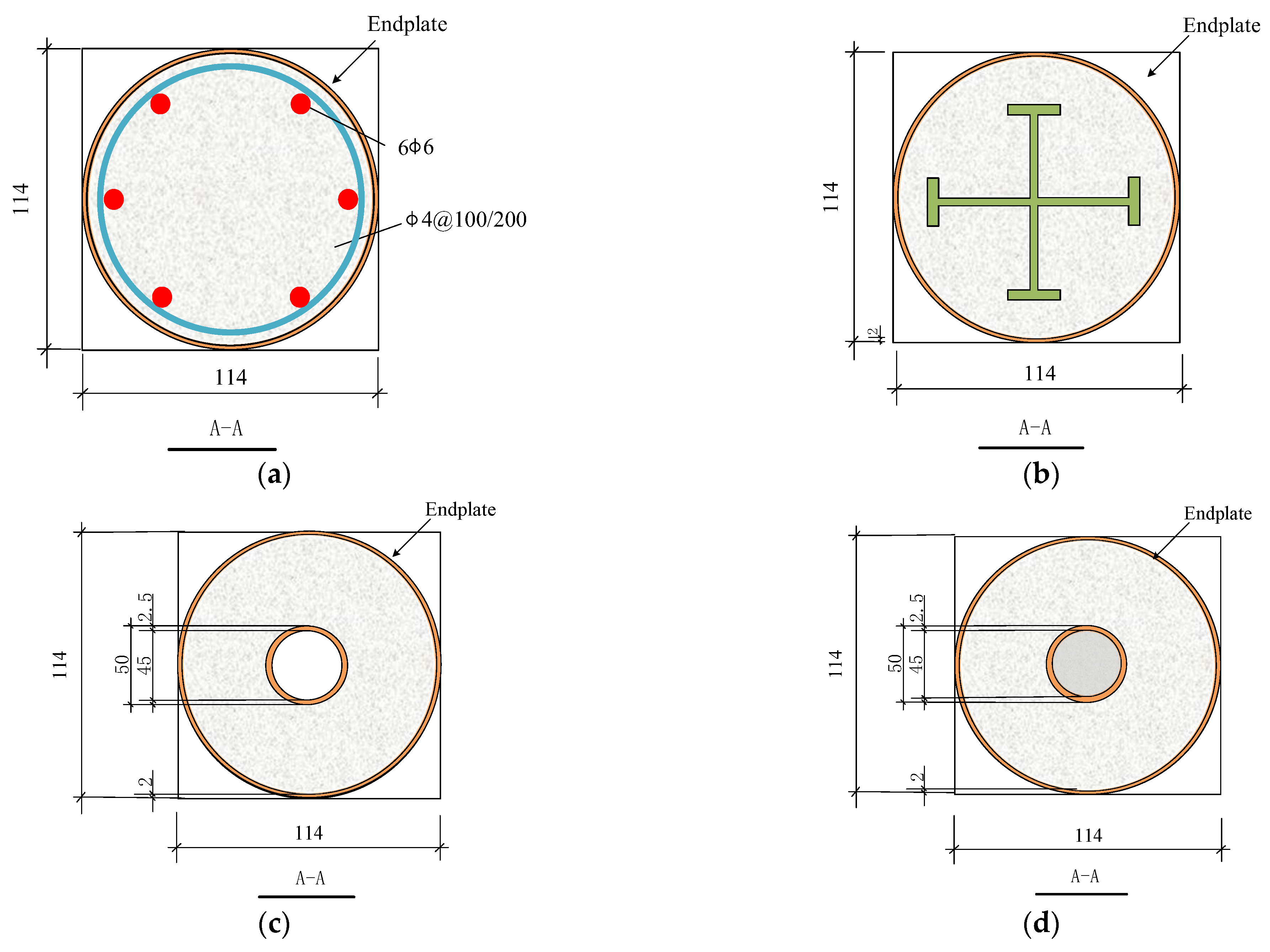
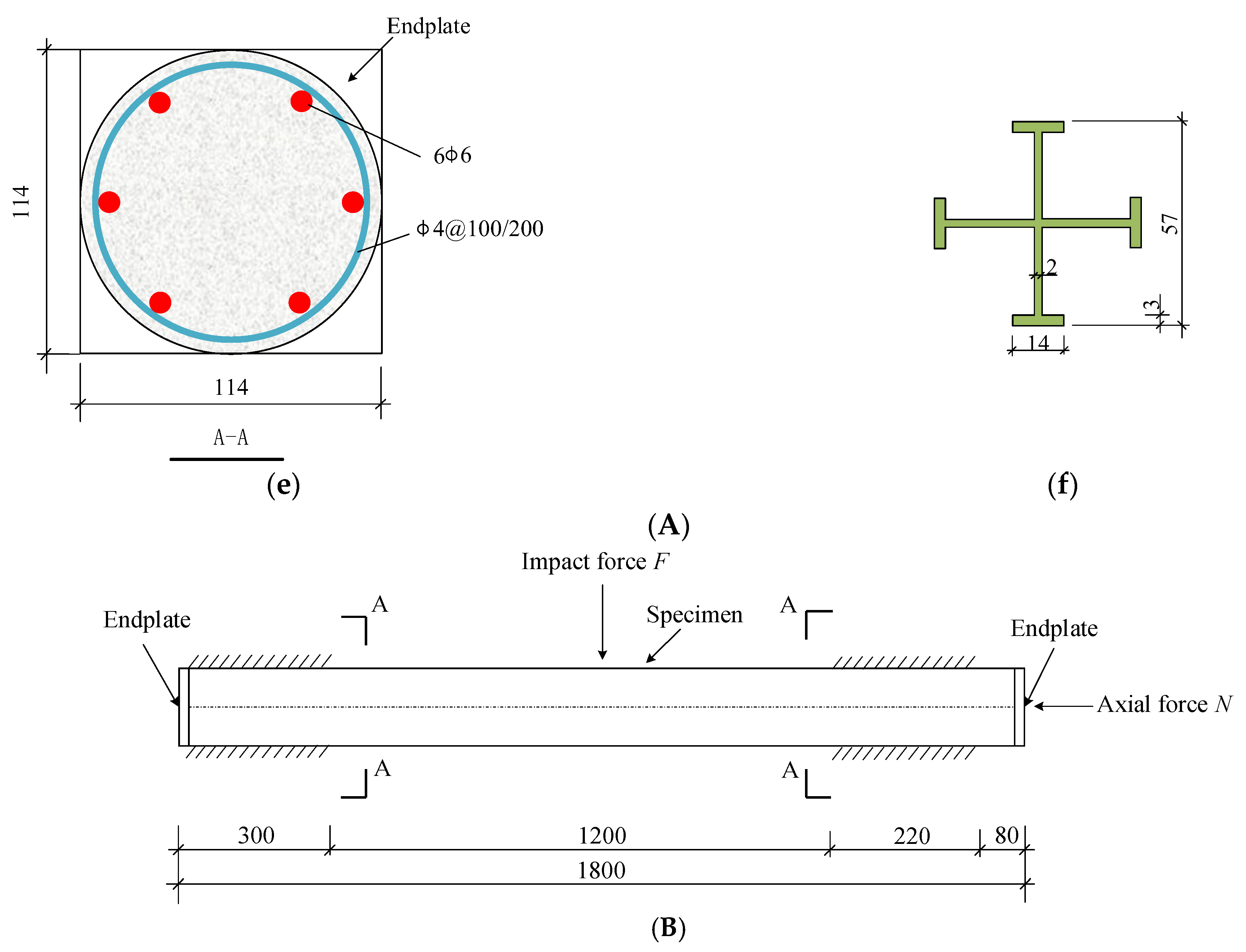
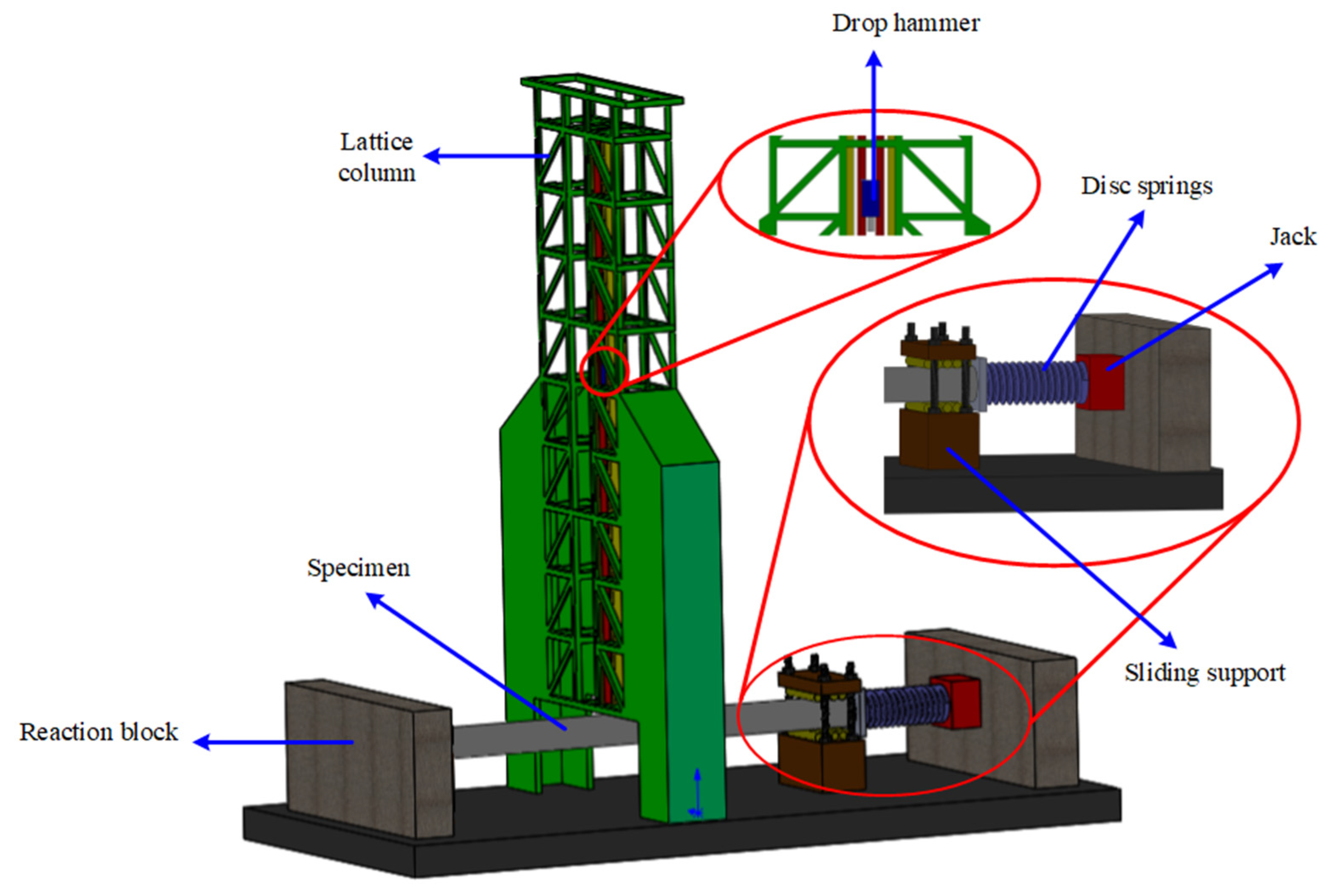

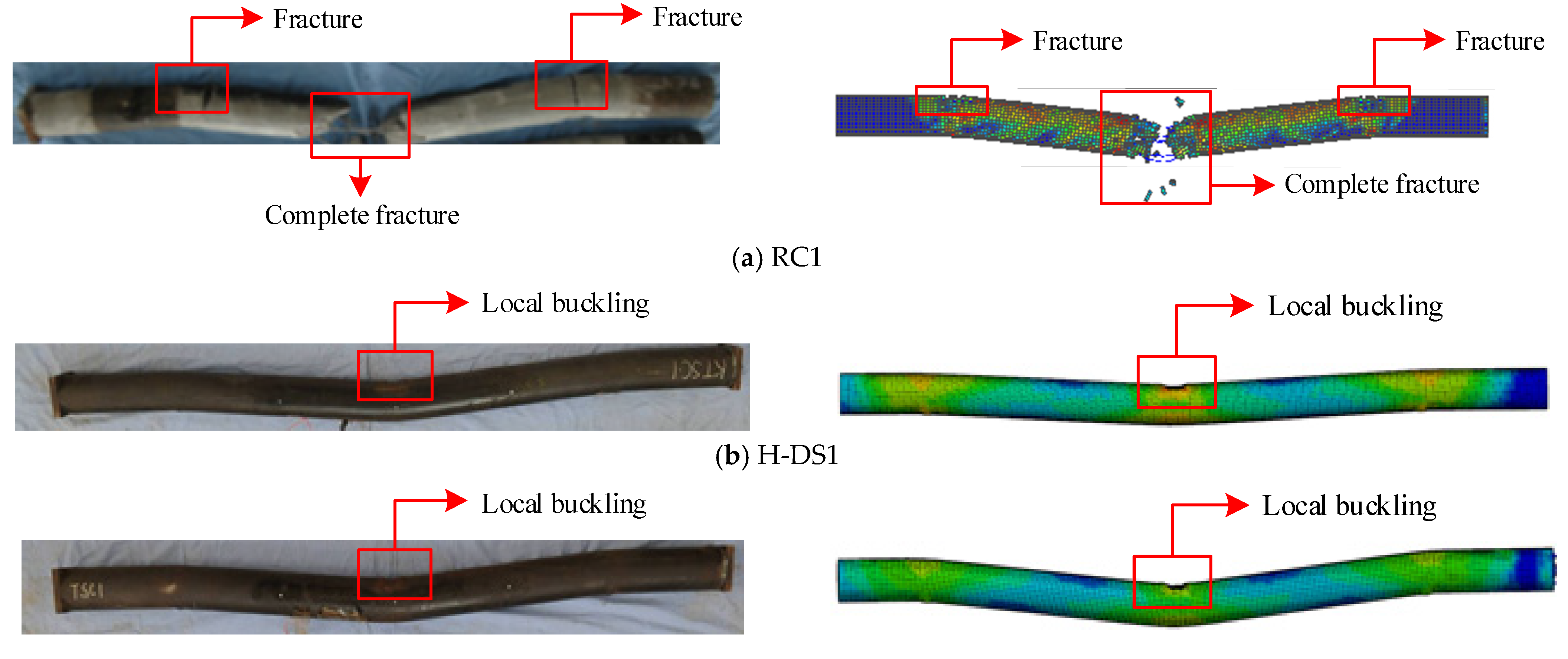

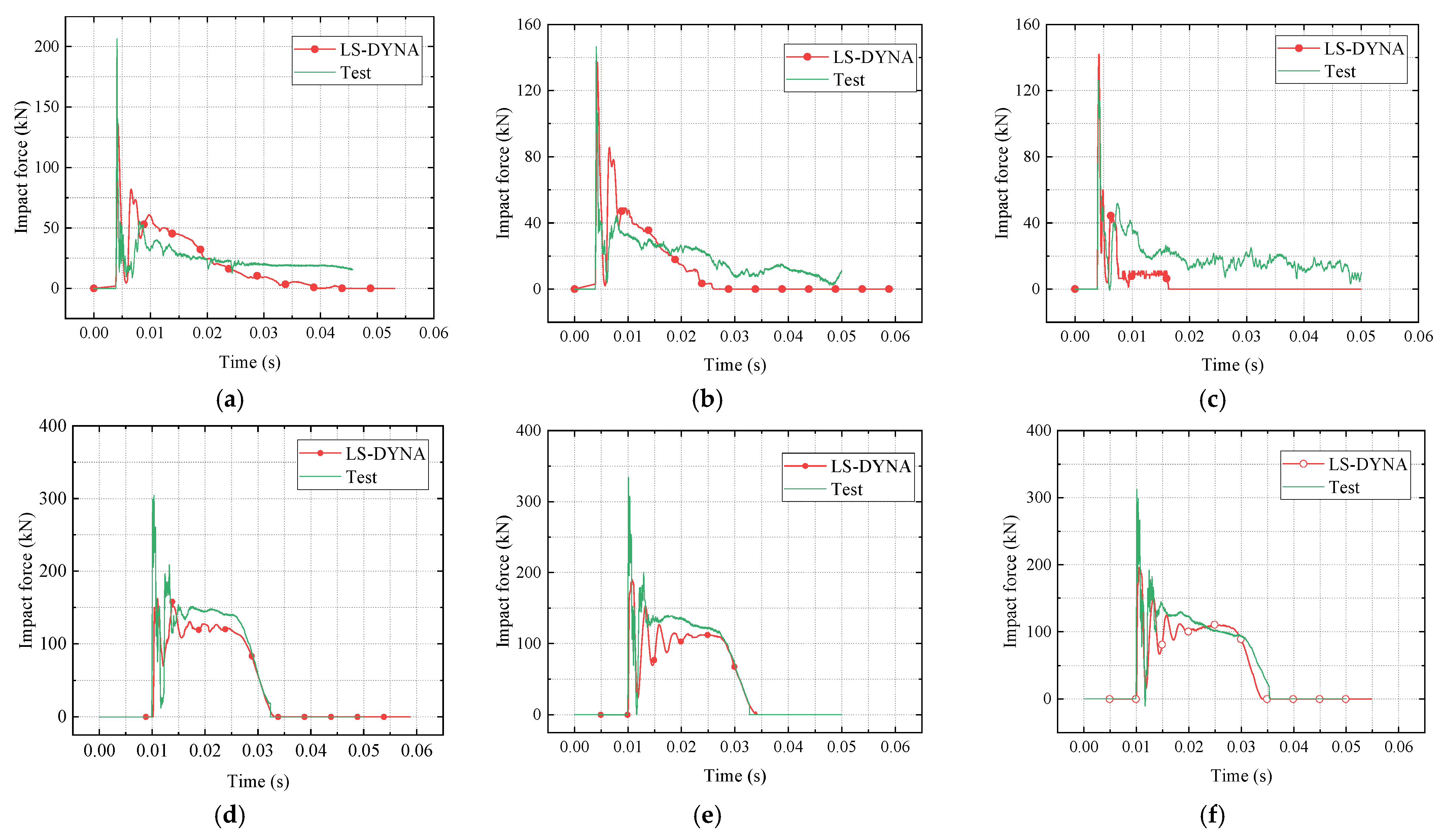

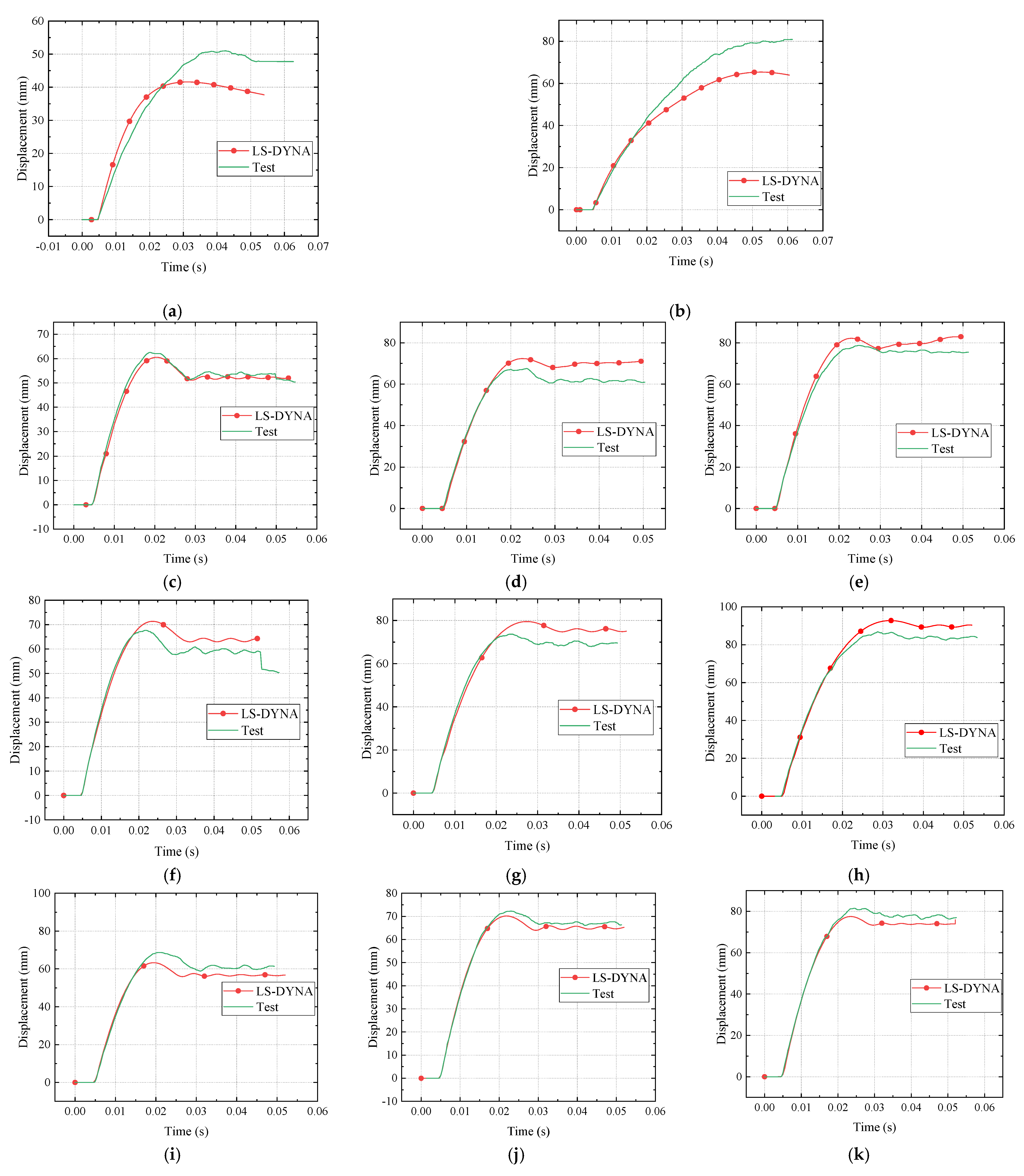


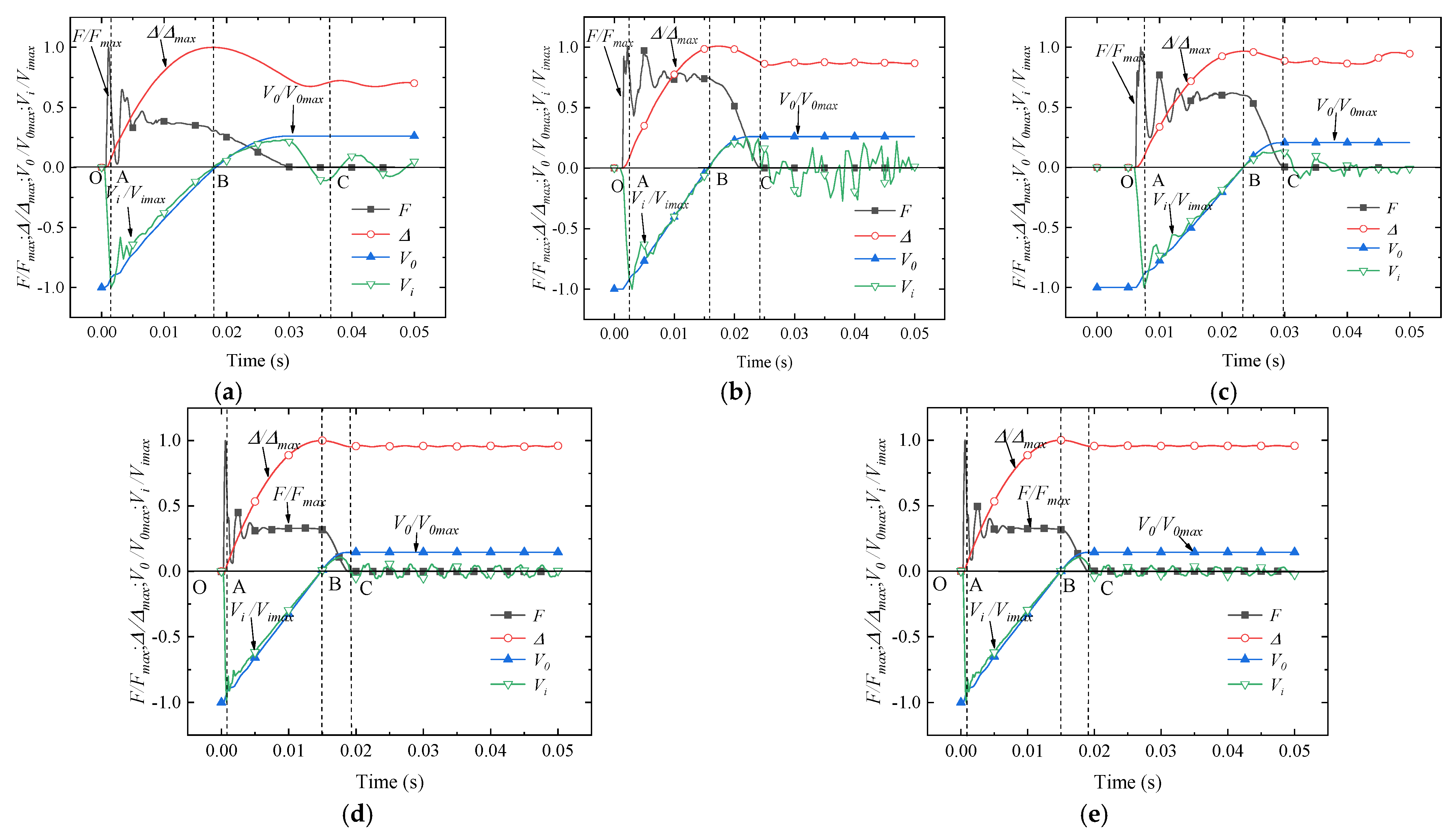
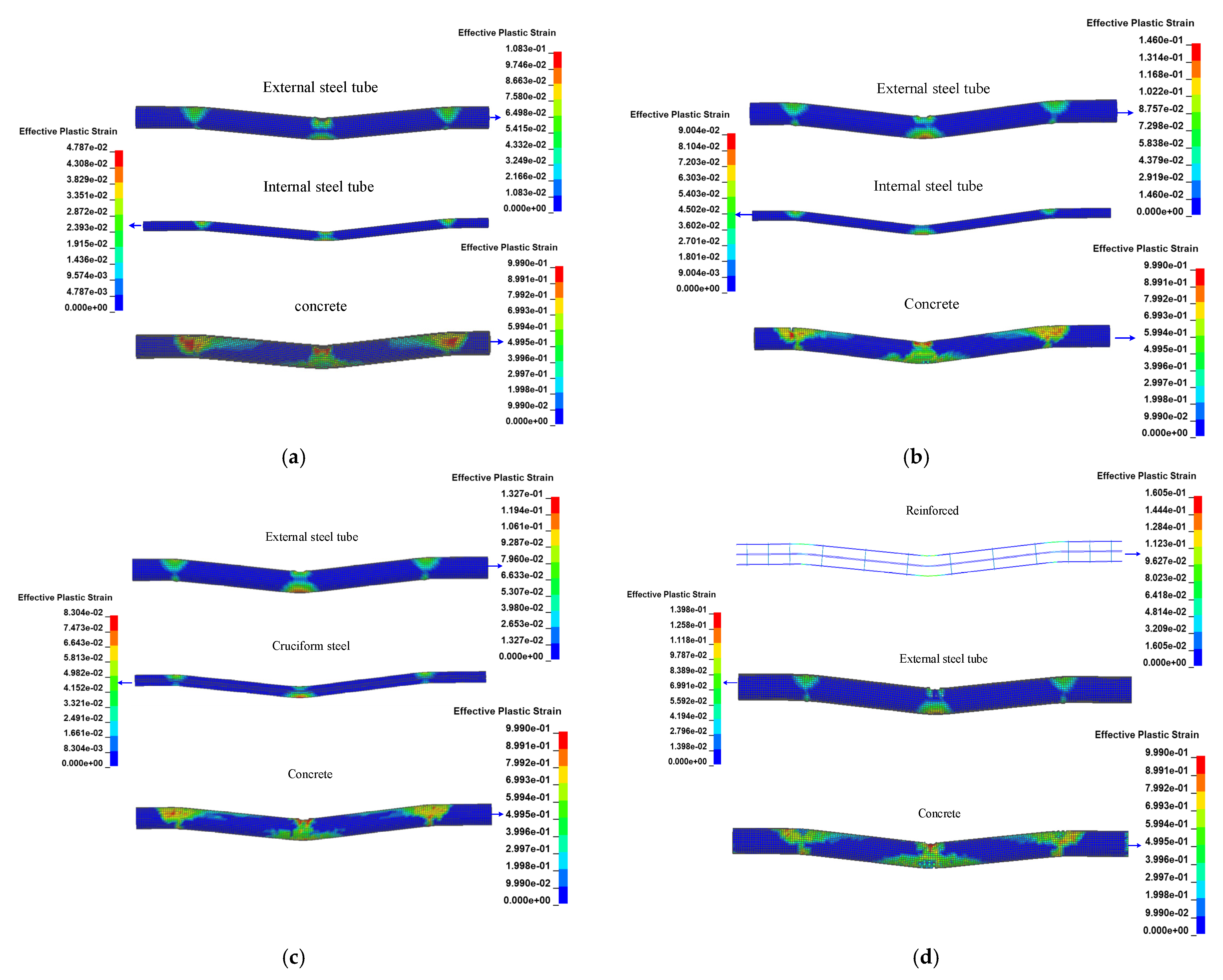
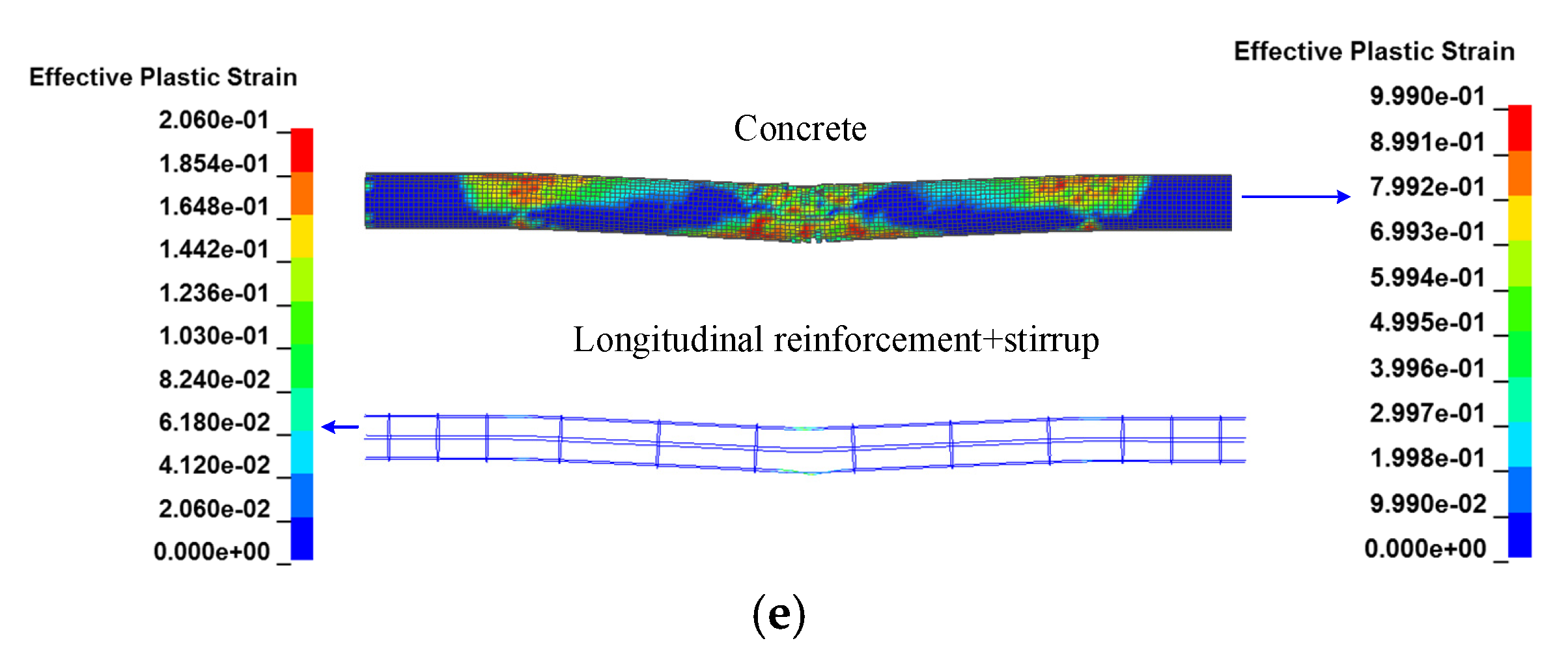






| The Name of the Specimen | ID | N0 (kN) | v0 (m/s) | m0 (kg) | Fstab (kN) | td (ms) | Δres (mm) | |||
|---|---|---|---|---|---|---|---|---|---|---|
| Test | FEA | Test | FEA | Test | FEA | |||||
| Reinforced concrete (RC) | RC1 | 0 | 4.43 | 206.65 | 27.40 | 30.56 | 46.10 | 44.72 | 50.90 | 37.70 |
| RC2 | 59 | 4.43 | 206.65 | 22.45 | 22.09 | 45.45 | 31.52 | 80.88 | 63.93 | |
| RC3 | 99 | 4.43 | 206.65 | 23.30 | 11.78 | 61.15 | 46.04 | — | — | |
| Steel tubular-encased reinforced concrete (R-ST) | R-ST1 | 0 | 9.39 | 206.65 | 135.24 | 129.33 | 23.60 | 21.19 | 56.72 | 60.82 |
| R-ST2 | 150 | 9.39 | 206.65 | 126.13 | 106.30 | 24.40 | 23.91 | 65.06 | 66.99 | |
| R-ST3 | 250 | 9.39 | 206.65 | 104.70 | 97.66 | 27.55 | 24.33 | 73.87 | 77.53 | |
| Steel-reinforced concrete-filled steel tube (S-ST) | S-ST1 | 0 | 9.39 | 206.65 | 131.45 | 109.26 | 23.35 | 27.45 | 63.65 | 59.12 |
| S-ST2 | 190 | 9.39 | 206.65 | 118.69 | 88.68 | 24.90 | 29.90 | 75.51 | 69.22 | |
| S-ST3 | 315 | 9.39 | 206.65 | 88.97 | 75.26 | 31.15 | 33.75 | 89.86 | 83.57 | |
| Hollow concrete-filled double steel tube (H-DS) | H-DS1 | 0 | 9.39 | 206.65 | 144.22 | 122.80 | 22.30 | 23.20 | 52.14 | 53.55 |
| H-DS2 | 170 | 9.39 | 206.65 | 129.50 | 108.11 | 23.40 | 24.25 | 70.05 | 61.67 | |
| H-DS3 | 285 | 9.39 | 206.65 | 112.96 | 105.96 | 25.55 | 24.05 | 80.17 | 75.67 | |
| Solid concrete-filled double steel tube (S-DS) | S-DS1 | 0 | 9.39 | 206.65 | 125.34 | 112.95 | 21.50 | 24.25 | 57.82 | 51.14 |
| S-DS2 | 215 | 9.39 | 206.65 | 133.90 | 110.50 | 23.20 | 23.45 | 68.17 | 58.85 | |
| S-DS3 | 355 | 9.39 | 206.65 | 113.27 | 112.80 | 24.65 | 22.85 | 76.37 | 69.54 | |
| Steel Type | Diameter of Steel Bar or Thickness of Steel Plate (mm) | Fy (MPa) | Fu (MPa) | Es (MPa) | |
|---|---|---|---|---|---|
| Stirrup | 4 | 603.5 | 770.5 | 2.23 | 0.104 |
| Longitudinal bar | 6 | 529.2 | 681.1 | 2.17 | 0.206 |
| Outer steel tube | 2 | 330.1 | 396.7 | 2.21 | 0.192 |
| Inner steel tube | 2.5 | 330.4 | 398.4 | 1.75 | 0.235 |
| Web of H-shaped steel | 2 | 295.1 | 356.2 | 1.95 | 0.317 |
| Flange of H-shaped steel | 3 | 295.3 | 362.4 | 1.92 | 0.322 |
Disclaimer/Publisher’s Note: The statements, opinions and data contained in all publications are solely those of the individual author(s) and contributor(s) and not of MDPI and/or the editor(s). MDPI and/or the editor(s) disclaim responsibility for any injury to people or property resulting from any ideas, methods, instructions or products referred to in the content. |
© 2023 by the authors. Licensee MDPI, Basel, Switzerland. This article is an open access article distributed under the terms and conditions of the Creative Commons Attribution (CC BY) license (https://creativecommons.org/licenses/by/4.0/).
Share and Cite
Li, X.; Yin, Y.; Li, T.; Zhu, X.; Wang, R. Analytical Study on Reinforced Concrete Columns and Composite Columns under Lateral Impact. Coatings 2023, 13, 152. https://doi.org/10.3390/coatings13010152
Li X, Yin Y, Li T, Zhu X, Wang R. Analytical Study on Reinforced Concrete Columns and Composite Columns under Lateral Impact. Coatings. 2023; 13(1):152. https://doi.org/10.3390/coatings13010152
Chicago/Turabian StyleLi, Xianhui, Yao Yin, Tieying Li, Xiang Zhu, and Rui Wang. 2023. "Analytical Study on Reinforced Concrete Columns and Composite Columns under Lateral Impact" Coatings 13, no. 1: 152. https://doi.org/10.3390/coatings13010152
APA StyleLi, X., Yin, Y., Li, T., Zhu, X., & Wang, R. (2023). Analytical Study on Reinforced Concrete Columns and Composite Columns under Lateral Impact. Coatings, 13(1), 152. https://doi.org/10.3390/coatings13010152







